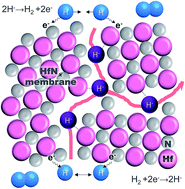Enhanced hydrogen permeability of hafnium nitride nanocrystalline membranes by interfacial hydride conduction†
Abstract
Hydrogen permeability based on mixed hydride ion electron conduction was demonstrated for hafnium nitride HfNx (film thickness of 100–500 nm, x = 0.8 and 1.0) nanocrystalline membranes. Nanocrystalline films with a (100) orientation and crystallite sizes of a few tens of nanometers were prepared on porous alumina supports by radio frequency (RF) reactive sputtering. Combined spectroscopic, permeability, and microbalance analysis suggests that the nanocrystalline matrices were readily hydrogenated by the formation of Hf–H terminal groups on the internal grain surfaces at ambient temperature and thus efficient hydrogen permeation took place due to an enhanced diffusion of hydridic defects through the grain boundaries; this was further aided by the Hf–H bond exchange process. Hence, membranes with an average crystallite size of 11 nm yielded a hydrogen flux of 6 × 10−7 mol cm−2 s−1 at 25 °C at an applied hydrogen partial pressure of 50 kPa; this value is higher than those exhibited by the current state-of-the-art Pd membranes. These findings establish a new concept for Pd alternatives based on the pronounced hydric conductivity of transition metal nitride nanomaterials.



 Please wait while we load your content...
Please wait while we load your content...